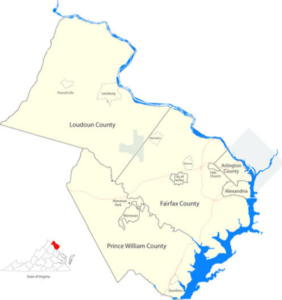
Active Prince William Co-Chairs Allen Muchnick and Mark Scheufler submitted the following statements for the Annual Joint Northern Virginia Transportation Public Meeting that was held on December 15, 2021.
Northern Virginia needs a transportation system that moves people and goods effectively, safely, equitably, and sustainably. Sadly, our region’s pursuit of wider and faster roads over the past 70-plus years has failed to achieve those objectives.
It’s long past time to stop expanding regional roadways for toll-free travel in single-occupant vehicles and instead focus new homes, jobs, and transportation investments in regional activity centers served by high-capacity public transportation and expeditiously retrofit existing arterial roads for safe and efficient travel by walking, bicycling, and bus transit.
Robust and strategic Vision Zero programs are needed at the statewide, regional, and local levels, and the region should prioritize completion of the National Capital Trail Network.
We appreciate this annual joint transportation meeting and public comment opportunity for Northern Virginia. However, the conspicuous absence of the National Capital Region Transportation Planning Board (or TPB) from this annual meeting should be promptly fixed, with or without state legislation.
With the TPB excluded, the public, elected officials, CTB members, and agency staff are not fully and fairly apprised of the TPB’s critical role as the federally designated metropolitan planning organization for the National Capital Region, which includes Planning District 8, and they are not kept aware of the TPB’s many policies (e.g., the TPB Vision, Regional Transportation Priorities Plan, Visualize 2045 Aspirational Initiatives, Equity Emphasis Areas, strategies to achieve regional goals for greenhouse gas reduction and for locating the bulk of new housing in regional activity centers served by high-capacity public transportation), priorities, objectives, studies, planning activities, and transportation project and system evaluation processes.
In addition, the TPB does allocate funds for several transportation programs, including the Transportation Alternatives Set-Aside, the FTA’s Enhanced Mobility Program (Section 5310), the TPB’s Transportation Land-Use Connection (TLC) technical assistance planning grants, the TPB’s new Transit within Reach technical assistance program, the TPB’s new Regional Roadway Safety Program, the Commuter Connections’ suite of transportation demand management programs, the Street Smart Safety Campaign, the TPB’s Unified Planning Work Program (UPWP), etc.
Transparent and impactful public involvement throughout the development of transportation projects is vital for creating better transportation projects.
The CTB and NVTA should require all localities or agencies to hold advertised public hearings on their proposed submissions for funding transportation projects with SMART SCALE, NVTA, CMAQ, RSTP, Revenue Sharing Program, Transportation Alternatives, HSIP, and other non-local funds before the project funding requests are formally submitted by staff and endorsed by the local governing body. Only if such advertised public hearings are held in advance by agency staff or a local advisory body should the governing body itself be relieved of holding a [second] public hearing and simply endorse the project funding submission(s) as a consent agenda item prior to any public comment opportunity.
The CTB and NVTA should also require localities to hold advertised public hearings that generally comply with VDOT public involvement guidelines before a locally administered transportation project is either advanced beyond a feasibility study or approved for construction. While VDOT has excellent public participation and environmental review procedures for its own projects. Virginia’s public involvement and environmental review requirements for locally administered projects are far less stringent. Locality transportation staff have long exploited lax VDOT oversight of locally administered projects to minimize input on the scope and design of transportation projects by the public and even elected officials.
Prince William County’s rigged and prematurely aborted feasibility and environmental assessment studies for its proposed Route 28 Bypass along the Flat Branch floodplain are prime examples of a corrupted public process. The City of Manassas has also repeatedly evaded meaningful public scrutiny of its Sudley Road Third Lane Project along Route 234 Business.
Thank you for the opportunity to address you tonight. To meet the regional, state, and federal greenhouse gas emission objectives and goals, a structural change in the transportation planning and investment needs to occur.
In addition to improved vehicle emission standards and investing in electric vehicles and infrastructure, vehicle miles traveled or VMT for Single Occupancy Vehicles as a whole needs to decrease even as the Northern Virginia population grows.
At a basic level, this means that we need to stop expanding unmanaged roadway lane miles. This means Northern Virginia’s section of the Visualize 2045 constrained long-range plan needs to be radically changed. Any government funding for highway expansion is one less dollar going to meeting these urgent climate goals in the transportation sector.
A large number of major roadway projects in Northern Virginia are going to be completed in the next few years that will dramatically increase the VMT in the region. We need to change the paradigm that Congestion is reduced–not by adding roadway supply to the system–but by reduced Single-Occupant-Vehicle travel demand. This will require reducing car dependency by developing near high-capacity transit, repurposing roadway space for transit and non-motorized users, and reforming parking requirements and level of service standards, especially in outer jurisdictions.
Route 1 in Fairfax County is an example of a project that we cannot afford to replicate. Instead of repurposing the existing roadway corridor with dedicated bus lanes, we are investing over $1 billion to keep or expand to six lanes of high-speed traffic plus added dedicated bus Lanes to create an unsafe environment for all users in the corridor that will take additional 10 years to complete.
But, most importantly, the public needs to be educated on why these structural changes in transportation planning and investment need to be implemented. We need to move away from “investments in ‘multimodal’ transportation solutions” to “investments in everything but projects that induce SOV travel demand”. We need to start tonight…time is running out. Thank you for considering this input.
###
